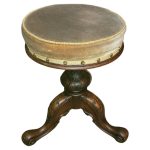British Tiger Oak Renaissance Revival Book Slide or Stand
PRESENTING A LOVELY British Tiger Oak Renaissance Revival Book Slide or Stand.
Made in England circa 1880-1900, as part of the ‘Renaissance Revival’ trend, of that period.
Made of beautifully patinated tiger oak and in a wonderful simplistic form.
Two hinged leaves on a plank base, with each leaf hand carved in a glorious hand-carved, scallop edged, acanthus leaf shape.
The leaves when open, support a selection of your favorite books for display and ease of access.
18.5 inches wide.
Not technically a ‘slide’ as it does not reduce/increase width and is probably better described, as a ‘Book Stand’.
1850-1880 Renaissance Revival
| Renaissance Revival – Proportions Medium to large. – Essential elements Rectilinear shapes. Prominent Renaissance and Neoclassical motifs such as columns, pediments, cartouches, rosettes, and carved masks; also plaques in porcelain, bronze. mother-of-pearl. Occasional Egyptian motifs. Veneer panels often framed by applied molding. Inscribed linear decoration. Turned or cutout parts on factory pieces; carving or elaborate inlay on finer examples. Forms sometimes adapted in cast iron. Woods – Walnut; also ash or pine for less expensive pieces. Oak was predominant in Britain. |
The Renaissance Revival style is often considered a reaction to the Rococo Revival, even though it was in use as early as 1850.
It is characterized by an eclectic use of both Renaissance and 18th-century Neoclassical motifs on straight-lined forms loosely based on 16th-century French models.
Porcelain, bronze, or mother-of-pearl plaques were popular embellishments on pieces within scribed, linear classical motifs.
The Renaissance Revival styles of the 1860s and 1870s marked the first period in which fine designs were used for mass-produced furnishings.
Furniture from the 1870s ranged from works made in shops employing skilled craftsmen to the products of large Midwestern factories. The New York shops, in particular, produced work with elegant detail and elaborate inlays, while the factories, centered primarily in Grand Rapids, manufactured pieces with turned and cut elements that could be produced more readily in volume and at lower cost. Since the Renaissance Revival style was based on rectangular shapes and prominent motifs, it could be successfully interpreted with either type of production.
Walnut was the most popular wood, with some veneer introduced as surface decoration. Light woods were favored in reaction to the prevailing dark woods of the Empire and Rococo Revival styles.
Common motifs were flowers, fruit, cartouches, medallions, contoured panels, caryatids, scrolls, classical busts, and animal heads, as well as architectural elements, usually without any structural intent, such as pediments, columns, and balusters.
Upholstery was prominently featured on chairs and sofas. Ornament from the then current Louis XVI Revival – popular with elegant New York cabinetmakers, who favored ebonizing and ormolu – was sometimes incorporated in the work of the 1860s. The Neo-Grec (or Neo-Greek) and Egyptian Revival styles were elaborate and exotic substyles of the Renaissance Revival.
Renaissance Revival furnishings were used in Italianate villas and other classically inspired houses.
1880-1900 Late 19th-Century Revival Styles
Trends affecting furniture design in the 1880s and 1890s were complex. While the Eastlake approach was adopted by many makers, there was also renewed interest in styles of the past. Previous mid-century revival furniture, however, was dismissed as inauthentic by many designers and their patrons. Historic styles were now carefully studied and collecting antiques became a serious pursuit in America.
Architects of the grandest homes of the era (in the so-called Beaux Arts style), inspired by Europe’s more palatial buildings, designed or commissioned equally grand furnishings for their interiors, from Renaissance-style Savonarola chairs to Louis XVI-style beds and settees.
British Tiger Oak Renaissance Revival Book Slide or Stand
Provenance: From a Dallas Estate with items of the period.
Condition: Very good. One hinge missing one screw.
Dimensions: 8.75 inches tall, 18.5 inches wide and 5.9 inches deep
SALE PRICE NOW: $375




















